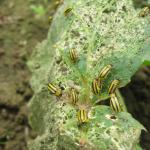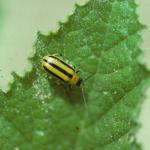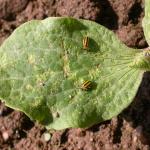Cucumber Beetle, Striped
Acalymma vittatum
Identification:
Striped cucumber beetles (SCB) are approximately 7 mm-long, yellow beetles with three black stripes that reach the end of the forewings, a yellow thorax, and a black head. Larvae are 9 mm long, creamy white with black heads and with three pairs of short legs. SCB eggs are pale orange-yellow and are laid in groups near the base of cucurbit plants.
Life Cycle:
Adults spend the winter in plant debris in field edges, with a small proportion remaining in the field. With the onset of warm days (usually mid-June), beetles move rapidly into young crops to feed, mate, and lay eggs at the base of the plants. High tunnel and greenhouse cucumbers draw beetles first, followed by early field crops. Densities can be very high, especially in non-rotated fields or close to last year’s cucurbit crops.
When the eggs hatch, the larvae develop for 2-4 weeks while feeding on the plant roots, then pupate in the soil. The next generation of adults emerge in early to mid-August; populations remain high through mid- to late September and then beetles move into field edges to find overwintering sites.
Crop Injury:
These adult beetles congregate in flowers and may cause damage to fruit, rendering it unmarketable. More mature plants can withstand more feeding damage than younger plants without experiencing a reduction in yield.
Beetle feeding spreads bacterial wilt to young and rapidly growing plants, especially before the 5-leaf stage. This can be more damaging than direct feeding injury. Cucumber and muskmelon are highly susceptible to wilt; watermelon is not.
Striped cucumber beetles can also vector viruses, including cucumber mosaic virus, but not as effectively as aphids.
Scouting & Threshold:
Cucurbit plants at the cotyledon and 1-to 2-leaf stages are more susceptible to infection with bacterial wilt than older plants. Thus, it is especially important to keep beetle numbers low before the 5-leaf stage. Start scouting immediately after transplanting or when seedlings emerge and continue scouting through the fruiting stage. Scout frequently (at least twice per week up to SCB emergence, and for two weeks after) and treat after beetles colonize the field. Scout at least 25 plants to monitor the number of beetles and damage.
The economic threshold depends on the crop. To prevent bacterial wilt in highly susceptible crops such as cucumber, muskmelons, summer squash, and zucchini, we recommend that beetles should not be allowed to exceed 1 beetle for every 2 plants. Less wilt-susceptible crops (butternut, watermelon, most pumpkins) will tolerate 1 or 2 beetles per plant without yield losses. Spray within 24 hours after the threshold is reached. Proper timing is key.
Cultural Controls & Prevention:
- Crop rotation can reduce the impact of cucumber beetles.
- Growing from transplants may allow plants to reach a later growth stage before beetles arrive, giving them the ability to withstand more feeding damage. Some repellents or systemics may be applied to transplants outside the greenhouse before setting in the field, which is convenient and allows lower rates of application.
- Row covers can exclude beetles from young cucurbits. Use hoops to prevent abrasion. In addition to insect protection, row covers also provide extra early-season heat, though it is important to remove them during flowering to allow for pollination.
- Perimeter trap cropping is another cultural control that has been shown to dramatically reduce or eliminate main crop sprays while providing effective beetle control. Trap cropping exploits the fact that SCB are more attracted to Cucurbita maxima crops (e.g. buttercup and hubbard squashes and giant pumpkins) than C. pepo or C. moschata crops (e.g. pumpkins, summer squash, butternut squash, other winter squash). Note that some specialty pumpkin varieties are C. maxima types and very attractive to beetles. Plant 1 or 2 rows of a C. maxima variety in an unbroken perimeter around the field. Always use 2 rows near woods or last year’s fields, and space plants no wider than the between-row spacing that is used in the main crop. Do not use a crop that is highly susceptible to bacterial wilt (see next paragraph) in the border. Beetles must be killed in the border, either by applying foliar insecticide when beetles first arrive or using a systemic insecticide at planting. Scout both borders and main crop to assess beetle numbers regularly. Repeat perimeter-sprays if needed to prevent influx into the main crop, and spray the main field if thresholds are exceeded. Attractive crop types that are planted in rows within the main field also work as trap crops that draw beetles as they move around within the field. These trap crops can be selectively sprayed. For more information about trap cropping:
- Beneficial nematodes: Some growers have expressed recent interest in applying entomopathogenic nematodes to the soil in order to control SCB. These nematodes would target the soil-dwelling, larval stage of SCB. Significant research has not been done on this topic, but theoretically it would be difficult to successfully control SCB using nematodes because of the high populations of SCB in the environments surrounding a field—if the SCB larva in the soil in a field were successfully killed, more adults will continue coming in from field edges throughout the season.
- Insect netting in high tunnels: SCB can be especially damaging early in the season in high tunnels. An increasing number of growers are experimenting with covering high tunnel sides and doorways with insect netting to exclude SCB. We’ve heard some success stories with this tactic, and some frustrations about ripping expensive netting, reduced airflow in netted tunnels, and incomplete exclusion that leads to resident high tunnel SCB populations. This tactic is best combined with crop rotation out of cucurbits in a netted tunnel so that the beetles that do make it into your tunnel one year will be unable to find food the following year. Consider using shade cloth to reduce heat in the tunnel when netting is used.
Chemical Control:
Sprays should be directed at adult beetles, as eggs and larvae are located in the soil and around the bases of plants, where they cannot easily be targeted. Insecticides should be applied before beehives are introduced into fields. Cucumber beetles are most active between dusk and dawn, so contact sprays are most effective if applied in the evening. Cucumber beetles arrive in a field and continue to colonize for about two weeks; if spraying a contact insecticide, wait until peak colonization before spraying to avoid spraying more than once.
It is important to consider the susceptibility of your crop to bacterial wilt when determining whether to spray contact or systemic insecticides. For susceptible crops, systemic insecticides may be more effective.
Conventional Insecticides
There are a number of broad-spectrum conventional insecticides which can be used for foliar control, including carbamates, pyrethroids, and neonicotinoids. All are highly toxic to bees and should only be used before bloom. Avoid using foliar neonicotinoid sprays (Actara [thiamethoxam] or Assail 30SG [acetameprid]) if systemics in the same class were used (see below). See the cucurbit insect management section of the New England Vegetable Management Guide for more details.
Systemic insecticides
Two neonicotinoid products, imidacloprid (multiple trade names) and thiamethoxam (Platinum) are registered for use in cucurbits as an in-furrow, banded, drench, or drip irrigation application to the seed/seedling root zone during or after planting/transplanting operations. Note specific application methods and rates on label. Commercially applied seed treatments (e.g. thiamethoxam, Farmore) are also available for early season control.
Organic insecticides
Kaolin clay (Surround WP), pyrethrin (Pyganic Crop Spray 5.0 EC), and Azera (mixture of pyrethrin and azadirachtin) are labeled for SCB. Surround does not kill the beetles but instead acts as a physical deterrent. With direct-seeded crops, apply Surround as soon as seedlings emerge if beetles are active. Transplants can be sprayed or dunked before setting out in the field. As with other insecticides, Surround must be re-applied after heavy rain and on new growth. Pyganic is a contact insecticide that provides a short-term knock-down with no residual effect. Spinosad (Entrust) is not labeled for and is not effective against SCB.
Non-target effects
The New England Vegetable Management Guide describes many steps that growers can take to protect honey bees and native pollinators when using insecticides. The issue of neonicotinoids in particular has received a great deal of attention in recent years. This is a group of insecticides that have a chemical structure very similar to nicotine. They have been widely used in agriculture because they are effective against a wide range of insects, have lower mammalian toxicity compared to older classes of insecticides, and because they can be absorbed by roots and moved through the entire plant, reducing the need for foliar sprays. This trait allows for applications to be made to soil or on seeds, with less exposure to humans and to natural enemies of insect pests. Neonicotinoids are highly toxic to bees, and label requirements prohibit use on blooming crops or where there are blooming weeds or borders. Additional concern about impact on bees arises because research has shown that detectable, low concentrations of neonicotinoids can move into pollen or nectar. These are present at sublethal concentrations but may affect the foraging behavior of bees or suppress their immune system. The long-term or colony effects of sublethal concentrations of neonicotinoids are difficult to assess in the field because bees from each colony travel long distances and forage in many different habitats and types of plants. In cucurbits, both native bees (e.g., squash bees and bumblebees) and honey bees visit flowers to gather both pollen and nectar and are essential to crop pollination. Research in cucurbits has shown that higher levels of neonicotinoids were found after foliar treatments and chemigated insecticides were applied during flowering. Lower levels were detected in treatment regimens that involved a single application at planting via seed treatment, a drench application to transplant trays, or transplant water treatment. Thus, growers should avoid high rates and multiple applications, especially through trickle irrigation as the crop approaches flowering.
For current information on chemical control of striped cucumber beetle, please visit the New England Vegetable Management Guide website.
Crops that are affected by this insect include:
--Updated by G. Higgins, October 2016. Management recommendations by Ruth Hazzard and Andrew Cavanagh, June 2022.
Sources: University of California IPM Pest Management Guidelines: Cucurbits, Cucumber Beetles, Cornell University Vegetable MD Online: Cucumer Beetles, Corn Rootworms, and Bacterial Wilt in Cucurbits
The Center for Agriculture, Food and the Environment and UMass Extension are equal opportunity providers and employers, United States Department of Agriculture cooperating. Contact your local Extension office for information on disability accommodations. Contact the State Center Director’s Office if you have concerns related to discrimination, 413-545-4800 or see ag.umass.edu/civil-rights-information.



